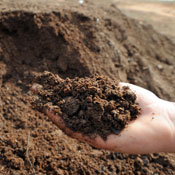Soil organic matter: Compost use

Compost trials by salad producer Vitacress have shown the potential to increase yields of spinach and rocket crops by about 10%, the firm’s farm agronomist, Shaun Clarkson, says.
Vitacress grows about 300ha of watercress, spinach, rocket and baby leaf salad crops on farms across southern England, often producing multiple crops a year.
The firm’s interest in improving soil organic matter began with recognition that salad and vegetable production worked land hard. “Organic matter in our soils is typically between 2-3%. By increasing it, we think we can increase yield and quality and make the system more sustainable in both dry and wet years,” Mr Clarkson says.
That would help increase confidence in being able to supply crops through more difficult parts of the year, allowing farms to deliver more reliable quality throughout the year. This would see Vitacress producing more UK-grown products.
“It also gives us an advantage over many in the industry who remain reliant on imported crops from Italy for much of the UK summer.”
A number of solutions are being investigated, including grass-clover leys and caliente cover crops. But compost has made the eye-catching difference in multiple trials.
“There has been some variability, but we have seen 10% yield increases relatively consistently where we have used compost.”
Those responses have been mostly in spinach and rocket crops, from the addition of either 15 or 30t/ha green waste compost, which costs about £12/t delivered.
The largest increases are seen when the crop is under stress, Mr Clarkson says. “When temperatures are not extreme and water and nutrients are relatively abundant, such as in 2011, then the benefits of compost are relatively less. But, as in 2010, when it was very hot and water was in short supply, we saw bigger improvements from using compost.”
Any yield increase over 5% starts to deliver a benefit, Mr Clarkson says. “A 10% yield increase gives a return of about £350-£400/ha.”
The finer details of maximising the use of compost are being tested in trials this season. “We’ve established there is a response, but we’re not entirely sure of the best timing yet. We’ve done various trials spreading the compost in the autumn or spring, with perhaps the best results coming from using it when bed-making just prior to drilling.”
Similarly, more work is being undertaken to understand how often compost needs to be applied – once a year, every three or five years, and what is the best application method.
The results have encouraged Vitacress to implement compost applications commercially. “Initially we’ve applied 30t/ha of compost to about 10% of our field in total last winter. We will monitor that, and if the results are positive we will continue with the programme within the rotation.”
The firm has had interesting results from growing caliente as a green manure cover crop. “We’ve fitted it into our production system by growing it over the winter. We drill it in mid-October and then incorporate it in the spring, usually about mid-March.”
Incorporating it quickly into the soil after chopping potentially could help with weed and disease suppression, he believes.
The main benefits, so far, have been in improving the water-holding capacity of the soil. “We’ve already seen a field requiring less water after growing caliente.”
Typically, salad crops are irrigated four times during the season, with three applications early in the season and one in the run-up to harvest. “In that field we didn’t need the one prior to harvest,” he says. “We also believe it helped produce a higher-quality crop.”

